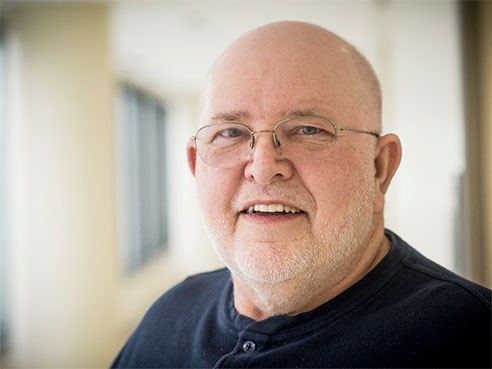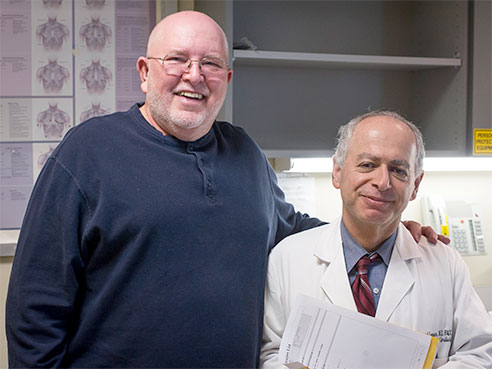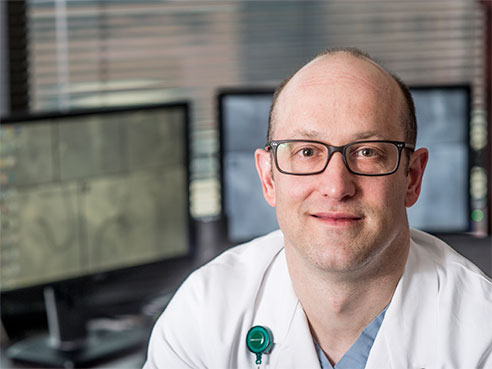 Paul CummingsSeventy-year-old Paul Cummings is not someone who enjoys down time. The Pensacola, Fla., resident and Hueytown native worked for Delta Air Lines for 29 years before retirement, which enabled him to further engage in his passion for painting.
Paul CummingsSeventy-year-old Paul Cummings is not someone who enjoys down time. The Pensacola, Fla., resident and Hueytown native worked for Delta Air Lines for 29 years before retirement, which enabled him to further engage in his passion for painting.
So when Cummings’ chest started hurting a couple of years ago, and he began gasping for air after walking no more than a few steps across a room, he knew he had a real problem.
“I got to the point where I didn’t know where my next gasp of breath was going to come from,” Cummings said. “It’s rough when you can’t walk 10 feet without getting out of breath — real rough.”
The cause of Cummings’ chest pain and breathing discomfort was a complete blockage of a coronary artery, also known as a chronic total occlusion, or CTO. This condition is responsible for a significant decrease in blood flow to the heart caused by a heavy atherosclerotic plaque buildup within the artery, resulting in a complete occlusion of the vessel.
The University of Alabama at Birmingham's nationally ranked Heart and Vascular Services is among the few heart centers in the United States to use a new minimally invasive method to unblock chronic total occlusions for the treatment of refractory chest pain. The new treatment may help prevent qualifying patients from needing bypass surgery, which is more invasive and involves a longer recovery time. If the patient cannot undergo bypass surgery, he or she may be relegated to a life of daily chest pain.
 From right: Cummings and LeesarThe treatment, called percutaneous coronary intervention of chronic total occlusions, involves using different devices and wires to cross the stenosis and open the totally occluded heart artery effectively and safely. A balloon catheter is then advanced across the lesion to break up the blockage, and a stent is inserted, reopening the artery.
From right: Cummings and LeesarThe treatment, called percutaneous coronary intervention of chronic total occlusions, involves using different devices and wires to cross the stenosis and open the totally occluded heart artery effectively and safely. A balloon catheter is then advanced across the lesion to break up the blockage, and a stent is inserted, reopening the artery.
Cummings was one of the first patients at UAB Hospital to undergo the procedure, in June 2013. Today, he says he is as healthy as he has been in years.
“I first started having shortness of breath two years ago, and I went on medication for a while and then had a heart attack in Florida when they ultimately tried to put a stent in,” Cummings said. “When we came to UAB, the doctor examined me and said, ‘We can fix this by drilling through the plaque and placing a stent in.’ Obviously, I was a little apprehensive at first; but this procedure has just been amazing. I knew I needed somebody that did cutting-edge things, and I’m glad I was able to come to UAB.”
UAB’s team has completed more than 20 CTO procedures, and the success rates fall right in line with the few other hospitals around the country that have completed more than 1,000 of these cases, says Massoud Leesar, M.D., professor of cardiovascular disease in UAB’s School of Medicine.
“The industry is into the third iteration of this CTO technology, and we have new devices and wires that make a huge difference in our success rates,” said Leesar, the cardiologist who performed Cummings’ procedure. “In the past, success rates were around 50 to 60 percent. Now, it’s closer to 80 to 90 percent. So while it is a procedure that takes some time — in rare cases up to four hours — it also takes a lot of effort and expertise. But whatever it takes, we’re here to do it.”
 Mark SasseThe fact that UAB can do these CTO procedures is not well-known among many cardiologists and general practitioners in Alabama, says Mark Sasse, M.D., associate professor of cardiovascular disease in UAB’s School of Medicine and one of several hospital interventional cardiologists who can perform the procedure. Sasse says general cardiologists do not know that CTOs can even be opened in some cases, and that they often recommend those patients for bypass surgery or medical management of their coronary artery disease.
Mark SasseThe fact that UAB can do these CTO procedures is not well-known among many cardiologists and general practitioners in Alabama, says Mark Sasse, M.D., associate professor of cardiovascular disease in UAB’s School of Medicine and one of several hospital interventional cardiologists who can perform the procedure. Sasse says general cardiologists do not know that CTOs can even be opened in some cases, and that they often recommend those patients for bypass surgery or medical management of their coronary artery disease.
“The dissemination of this knowledge about the CTO technology has been kind of limited,” Sasse said. “These are procedures that take a longer time than a more straightforward stent procedure, and it takes a dedicated staff like you would find at an academic center. Thankfully, because of the hyperspecialization we have in UAB Hospital, we can do a lot more of these types of procedures than the average interventionalists.”
Cummings is certainly grateful. He worked part time for Procter & Gamble this past year and logged almost 1,000 hours of installing equipment in restaurants in 2013 after his procedure.
A former art major in UAB’s School of Education in 1974, and charter member and past president of the UAB Art Club, Cummings also continues to engage his painting passion every Tuesday at the Quayside Art Gallery in Pensacola, where he is president of the Pensacola Art Studies Club. His wife, Norma, bought him watercolor lessons for Valentine’s Day in 2013, and he’s doing his best to improve.
